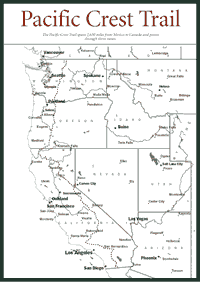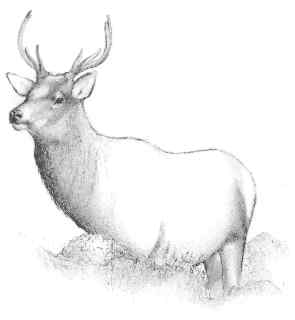
Pacific Crest Trail
[Fig. 60] The
2,650-mile Pacific Crest Trail covers more ground than any other route on
the West Coast. The Pacific Crest stretches over 24 national forests and
33 wildernesses from the Canadian border to the Mexican border. In California
alone, the trail is 1,723 miles long. It covers more than 500 miles in the
Sierra Nevada.
There are people who walk for four to six months and complete an end-to-end
trip. Richard Watson is reportedly the first person ever to hike the whole
trail. He did it in 1972. But many folks hike the Pacific Crest in segments.
In fact, some people hike segments of the segments because even smaller
chunks of the Pacific Crest can be pretty long.
The longest Pacific Crest stretch in California is 177 miles of high-elevation
trail that coincides with a large part of the John Muir Trail from the Southern
Sierra to Yosemite National Park. That stretch takes most experienced and
fit hikers three weeks to a month.
There are many strategies for walking the Pacific Crest Trail, but the common
thread among them is packing and traveling light. Two decades ago, people
commonly carried a 50-, 60-, or even 70-pound pack. Now, with ultralight
backpacking techniques, people carry 20- to 25-pound packs and travel much
farther in a single day. Other people use llamas to pack their provisions.
Llamas, which are native to high-elevation areas, adapt well to carrying
loads in the high Sierra.
The history of the Pacific Crest Trail can be traced to the 1920s when the
first serious discussions about it began. The trail was the product of many
minds. Clinton C. Clarke, a Southern California resident and chairman of
the Mountain League of Los Angeles, organized the Pacific Crest Trail System
Conference in 1932. But the idea had been considered since the mid-1920s
among several groups on the West Coast.
It took several decades of exploration, trail work, and lobbying before
the federal government included the Pacific Crest in a 1968 law called the
National Trails System Act. The act established the existing Appalachian
Trail and the Pacific Crest as the first two National Scenic Trails. A general
trail route was federally approved for the Pacific Crest in the early 1970s.
The Pacific Crest National Scenic Trail Advisory Council was named to develop
the detailed route and management plan for the trail. The council held its
first meeting in 1970. There were representatives of all three states involved—Washington,
Oregon, and California—as well as cattle ranchers, timber and mineral
interests, youth organizations, and Native Americans.
 In
1977, the Pacific Crest Trail Association was incorporated as construction
of the trail progressed. The association acted as an advocacy group for
the trail and assisted the government with volunteer work crews to maintain
and protect the trail. Today the group continues its advocacy and trail
work and provides information on everything from trail ethics to food supply
points along the route.
In
1977, the Pacific Crest Trail Association was incorporated as construction
of the trail progressed. The association acted as an advocacy group for
the trail and assisted the government with volunteer work crews to maintain
and protect the trail. Today the group continues its advocacy and trail
work and provides information on everything from trail ethics to food supply
points along the route.
The association worked with the U.S. Forest Service, the National Park Service,
the Bureau of Land Management, and a dizzying array of local governments
and private landowners to establish and maintain the trail. In 1993, after
years of land acquisition, trail cutting, and work on mapping, the trail
was officially dedicated as a National Scenic Trail, a quarter of a century
after it had been established as a National Scenic Trail.
The Pacific Crest has five sections, each several hundred miles long. The
Southern California section is 648 miles; Central California is 505 miles;
Northern California is 567 miles; Oregon is 430 miles; and Washington is
500 miles. Much of the trail is under snow throughout the winter, especially
in the Sierra Nevada. The optimum travel months in the Sierra are July,
August, and September.
The trail is marked with signs, not blazes. Even so, do not attempt any
lengthy section of the Pacific Crest without a good topographic map, compass,
and path-finding skills. Plan the trip many months in advance to make sure
you get the proper permits, which can be obtained from U.S. Forest Service
in each of the forests through which the trail passes. In many parts of
the Sierra, exit routes may mean a halfday or more of hiking. The Pacific
Crest has a remarkable amount of foot traffic, so you probably will not
be alone. But be prepared to handle problems on your own.
For more information: Pacific Crest Trail Association, 5325 Elkhorn
Boulevard, Suite 256, Sacramento, CA 95842-2526. Phone (916) 349-2109.
Read
and add comments about this page
Reader-Contributed Links to the California Sierra Nevada Book:
 In
1977, the Pacific Crest Trail Association was incorporated as construction
of the trail progressed. The association acted as an advocacy group for
the trail and assisted the government with volunteer work crews to maintain
and protect the trail. Today the group continues its advocacy and trail
work and provides information on everything from trail ethics to food supply
points along the route.
In
1977, the Pacific Crest Trail Association was incorporated as construction
of the trail progressed. The association acted as an advocacy group for
the trail and assisted the government with volunteer work crews to maintain
and protect the trail. Today the group continues its advocacy and trail
work and provides information on everything from trail ethics to food supply
points along the route.
